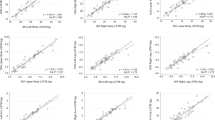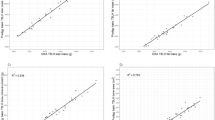Abstract
Background/objectives:
Dual-energy X-ray absorptiometry (DXA) is an accurate and reliable method for determining body composition, but a limiting feature is the restricted scanning areas (∼190 × 60 cm2). This shortcoming is relevant not only to athletes involved in sports where height is a major performance determinant but also to obese individuals with a large trunk mass and breadth in whom body dimensions frequently exceed the scan area. This study reviews solutions for DXA length and/or width limitations and its accuracy for body composition assessment using the PRISMA statement guidelines.
Subjects/methods:
Reviewed studies included English language articles from MEDLINE and Thomson Reuters Web of Knowledge platform (1990–2013), and were selected if procedures to overcome the scan area limitations and its validity in assessing the body composition of healthy participants were addressed. Search terms included: DXA, scan, height, width, length, wide, large, tall and obese.
Results:
A total of seven studies met the criteria and were selected. The sum of two DXA scans and adopting a knee-bent position are alternative procedures proposed for evaluating individuals using pencil and fan-beam Hologic instruments, who are taller than the scan area, whereas a half-body scan is recommended for overcoming the limitations of whole-body measurements in subjects who are wider than the scan area width of Lunar densitometers.
Conclusions:
Overall, the proposed procedures are useful and valid, in particular the half-body scan alternative, which avoids unnecessary radiation exposure and scanning time. However, these alternatives were developed for specific densitometers, models and scan mode, and applicability to other instruments requires further research.
This is a preview of subscription content, access via your institution
Access options
Subscribe to this journal
Receive 12 print issues and online access
$259.00 per year
only $21.58 per issue
Buy this article
- Purchase on Springer Link
- Instant access to full article PDF
Prices may be subject to local taxes which are calculated during checkout





Similar content being viewed by others
References
Wang ZM, Deurenberg P, Guo SS, Pietrobelli A, Wang J, Pierson RN Jr et al. Six-compartment body composition model: inter-method comparisons of total body fat measurement. Int J Obes Relat Metab Disord 1998; 22: 329–337.
Brozek J, Grande F, Anderson JT . Densitometry analysis of body composition: revision of some quantitative assumptions. Ann NY Acad Sci 1963; 110: 113–140.
Siri WE . Body composition from fluid spaces and density: Analysis of method. In: Techniques for Measuring Body Composition. Henschel IJBA (eds). National Academy of Sciences, National Research Council: Washington, D.C., 1961; pp 223–244.
Fuller NJ, Jebb SA, Laskey MA, Coward WA, Elia M . Four-component model for the assessment of body composition in humans: comparison with alternative methods, and evaluation of the density and hydration of fat-free mass. Clin Sci (Colch) 1992; 82: 687–693.
Withers RT, LaForgia J, Pillans RK, Shipp NJ, Chatternon BE, Schultz CG et al. Comparisons of two-, three-, and four-compartment models of body composition analysis in men and women. J Appl Physiol 1998; 85: 238–245.
Heymsfield SB, Wang Z, Baumgartner RN, Ross R . Human body composition: advances in models and methods. Annu Rev Nutr 1997; 17: 527–558.
Wang Z, Pi-Sunyer FX, Kotler DP, Wielopolski L, Withers RT, Pierson RN Jr et al. Multicomponent methods: evaluation of new and traditional soft tissue mineral models by in vivo neutron activation analysis. Am J Clin Nutr 2002; 76: 968–974.
Pietrobelli A, Formica C, Wang Z, Heymsfield SB . Dual-energy X-ray absorptiometry body composition model: review of physical concepts. Am J Physiol 1996; 271: E941–E951.
Cordero-MacIntyre ZR, Peters W, Libanati CR, Espana RC, Abila SO, Howell WH et al. Reproducibility of DXA in obese women. J Clin Densitom 2002; 5: 35–44.
Genton L, Karsegard VL, Zawadynski S, Kyle UG, Pichard C, Golay A et al. Comparison of body weight and composition measured by two different dual energy X-ray absorptiometry devices and three acquisition modes in obese women. Clin Nutr 2006; 25: 428–437.
Hind K, Oldroyd B, Truscott JG . In vivo precision of the GE Lunar iDXA densitometer for the measurement of total body composition and fat distribution in adults. Eur J Clin Nutr 2011; 65: 140–142.
Rothney MP, Martin FP, Xia Y, Beaumont M, Davis C, Ergun D et al. Precision of GE lunar iDXA for the measurement of total and regional body composition in nonobese adults. J Clin Densitom 2012; 15: 399–404.
Arngrimsson S, Evans EM, Saunders MJ, Ogburn CL 3rd, Lewis RD, Cureton KJ . Validation of body composition estimates in male and female distance runners using estimates from a four-component model. Am J Human Biol 2000; 12: 301–314.
Chen Z, Wang Z, Lohman T, Heymsfield SB, Outwater E, Nicholas JS et al. Dual-energy X-ray absorptiometry is a valid tool for assessing skeletal muscle mass in older women. J Nutr 2007; 137: 2775–2780.
Deurenberg-Yap M, Schmidt G, van Staveren WA, Hautvast JG, Deurenberg P . Body fat measurement among Singaporean Chinese, Malays and Indians: a comparative study using a four-compartment model and different two-compartment models. Br J Nutr 2001; 85: 491–498.
Goran MI, Toth MJ, Poehlman ET . Assessment of research-based body composition techniques in healthy elderly men and women using the 4-compartment model as a criterion method. Int J Obes Relat Metab Disord 1998; 22: 135–142.
Silva AM, Minderico CS, Teixeira PJ, Pietrobelli A, Sardinha LB . Body fat measurement in adolescent athletes: multicompartment molecular model comparison. Eur J Clin Nutr 2006; 60: 955–964.
Van Der Ploeg GE, Withers RT, Laforgia J . Percent body fat via DEXA: comparison with a four-compartment model. J Appl Physiol 2003; 94: 499–506.
Visser M, Fuerst T, Lang T, Salamone L, Harris TB . Validity of fan-beam dual-energy X-ray absorptiometry for measuring fat-free mass and leg muscle mass. Health, Aging, and Body Composition Study—Dual-Energy X-ray Absorptiometry and Body Composition Working Group. J Appl Physiol 1999; 87: 1513–1520.
Wang J, Thornton JC, Horlick M, Formica C, Wang W, Pierson RN Jr . Dual X-Ray absorptiometry in pediatric studies: changing scan modes alters bone and body composition measurements. J Clin Densitom 1999; 2: 135–141.
Centers for Disease Control and Prevention. NHANES 1999–2000 Public Data Release File Documentation. http://www.cdc.gov/nchs/data/nhanes/gendoc.pdf1999.
Schoeller DA, Tylavsky FA, Baer DJ, Chumlea WC, Earthman CP, Fuerst T et al. QDR 4500 A dual-energy X-ray absorptiometer underestimates fat mass in comparison with criterion methods in adults. Am J Clin Nutr 2005; 81: 1018–1025.
Liberati A, Altman DG, Tetzlaff J, Mulrow C, Gotzsche PC, Ioannidis JP et al. The PRISMA statement for reporting systematic reviews and meta-analyses of studies that evaluate health care interventions: explanation and elaboration. PLoS Med 2009; 6: e1000100.
Toombs RJ, Ducher G, Shepherd JA, De Souza MJ . The impact of recent technological advances on the trueness and precision of DXA to assess body composition. Obesity (Silver Spring) 2012; 20: 30–39.
Brownbill RA, Ilich JZ . Measuring body composition in overweight individuals by dual energy x-ray absorptiometry. BMC Med Imaging 2005; 5: 1.
Rodriguez NR, Di Marco NM, Langley S . American College of Sports Medicine position stand. Nutrition and athletic performance. Med Sci Sports Exerc 2009; 41: 709–731.
Genton L, Hans D, Kyle UG, Pichard C . Dual-energy X-ray absorptiometry and body composition: differences between devices and comparison with reference methods. Nutrition 2002; 18: 66–70.
Nana A, Slater GJ, Hopkins WG, Burke LM . Techniques for undertaking dual-energy X-ray absorptiometry whole-body scans to estimate body composition in tall and/or broad subjects. Int J Sport Nutr Exerc Metab 2012; 22: 313–322.
Santos DA, Gobbo LA, Matias CN, Petroski EL, Goncalves EM, Cyrino ES et al. Body composition in taller individuals using DXA: a validation study for athletic and non-athletic populations. J Sports Sci 2012; 31: 405–413.
Evans EM, Prior BM, Modlesky CM . A mathematical method to estimate body composition in tall individuals using DXA. Med Sci Sports Exerc 2005; 37: 1211–1215.
Silva AM, Baptista F, Minderico CS, Rodrigues AR, Pietrobelli A, Teixeira PJ . Calibration models to measure body composition in taller subjects using DXA. Int J Body Comp Res 2004; 2: 165–173.
Tataranni PA, Ravussin E . Use of dual-energy X-ray absorptiometry in obese individuals. Am J Clin Nutr 1995; 62: 730–734.
Mazess RB, Barden HS, Bisek JP, Hanson J . Dual-energy x-ray absorptiometry for total-body and regional bone-mineral and soft-tissue composition. Am J Clin Nutr 1990; 51: 1106–1112.
Rothney MP, Brychta RJ, Schaefer EV, Chen KY, Skarulis MC . Body composition measured by dual-energy X-ray absorptiometry half-body scans in obese adults. Obesity (Silver Spring) 2009; 17: 1281–1286.
Breithaupt P, Colley RC, Adamo KB . Body composition measured by dual-energy X-ray absorptiometry half-body scans in obese children. Acta Paediatr 2011; 100: e260–e266.
Lin LI . A concordance correlation coefficient to evaluate reproducibility. Biometrics 1989; 45: 255–268.
Bland JM, Altman DG . Statistical methods for assessing agreement between two methods of clinical measurement. Lancet 1986; 1: 307–310.
McBride GB . A Proposal for Strength-of-Agreement Criteria for Lin’s Concordance Correlation Coefficient. National Institute of Water & Atmospheric Research Ltd: Hamilton, 2005.
Oldroyd B, Smith AH, Truscott JG . Cross-calibration of GE/Lunar pencil and fan-beam dual energy densitometers—bone mineral density and body composition studies. Eur J Clin Nutr 2003; 57: 977–987.
Tothill P, Hannan WJ, Wilkinson S . Comparisons between a pencil beam and two fan beam dual energy X-ray absorptiometers used for measuring total body bone and soft tissue. Br J Radiol 2001; 74: 166–176.
Mahon AK, Flynn MG, Iglay HB, Stewart LK, Johnson CA, McFarlin BK et al. Measurement of body composition changes with weight loss in postmenopausal women: comparison of methods. J Nutr Health Aging 2007; 11: 203–213.
Santos DA, Silva AM, Matias CN, Fields DA, Heymsfield SB, Sardinha LB . Accuracy of DXA in estimating body composition changes in elite athletes using a four compartment model as the reference method. Nutr Metab (Lond) 2010; 7: 22.
van Marken Lichtenbelt WD, Hartgens F, Vollaard NB, Ebbing S, Kuipers H . Body composition changes in bodybuilders: a method comparison. Med Sci Sports Exerc 2004; 36: 490–497.
Acknowledgements
This work was supported by the Portuguese Foundation for Science and Technology (grant: PTDC/DES/098963/2008).
Author information
Authors and Affiliations
Corresponding author
Ethics declarations
Competing interests
The authors declare no conflict of interest.
Rights and permissions
About this article
Cite this article
Silva, A., Heymsfield, S. & Sardinha, L. Assessing body composition in taller or broader individuals using dual-energy X-ray absorptiometry: a systematic review. Eur J Clin Nutr 67, 1012–1021 (2013). https://doi.org/10.1038/ejcn.2013.148
Received:
Revised:
Accepted:
Published:
Issue Date:
DOI: https://doi.org/10.1038/ejcn.2013.148
Keywords
This article is cited by
-
Association between obesity-related dyspnea in daily living, lung function and body composition analyzed by DXA: a prospective study of 130 patients
BMC Pulmonary Medicine (2022)
-
Official position of the Brazilian Association of Bone Assessment and Metabolism (ABRASSO) on the evaluation of body composition by densitometry: part I (technical aspects)—general concepts, indications, acquisition, and analysis
Advances in Rheumatology (2022)
-
Body composition in males with adolescent idiopathic scoliosis: a case–control study with dual-energy X-ray absorptiometry
BMC Musculoskeletal Disorders (2016)
-
The role of DXA in sarcopenia
Aging Clinical and Experimental Research (2016)
-
An approach to quantifying abnormalities in energy expenditure and lean mass in metabolic disease
European Journal of Clinical Nutrition (2014)



